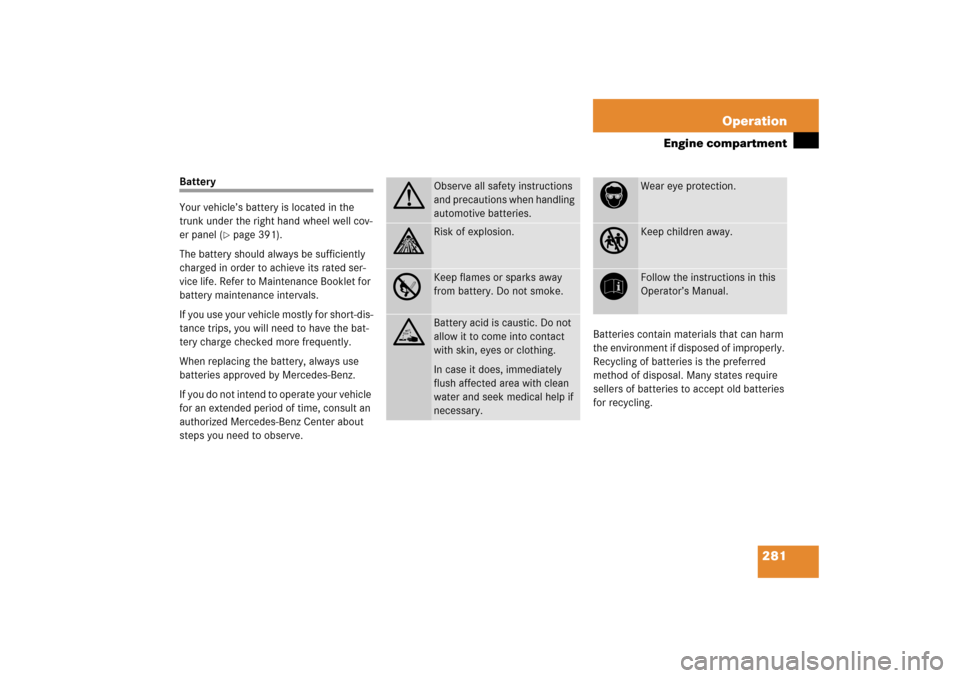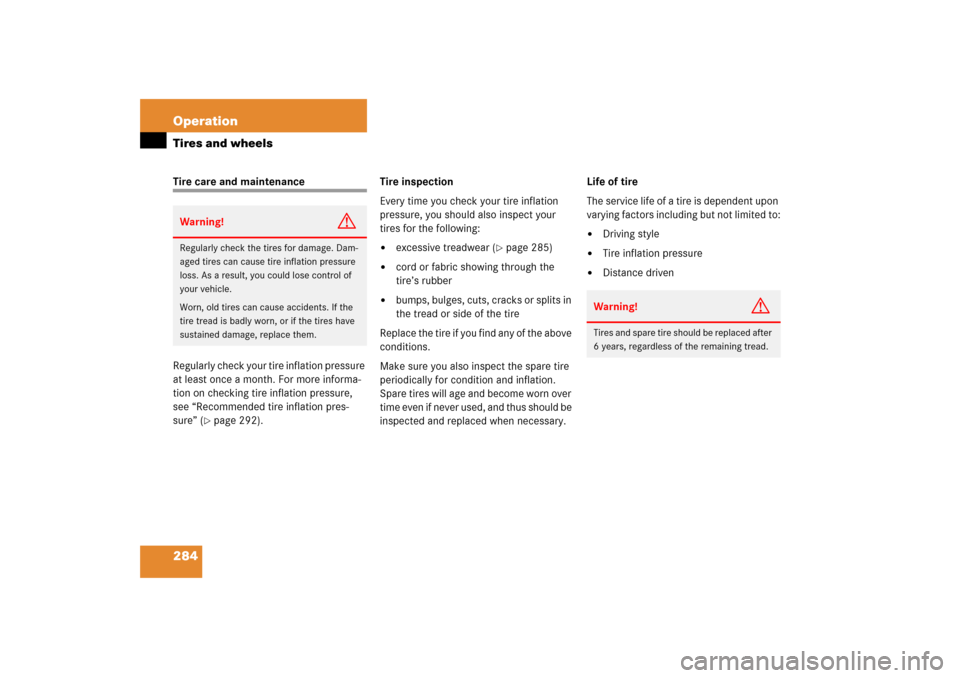Page 258 of 456
257 Operation
The first 1000 miles (1500 km)
Driving instructions
At the gas station
Engine compartment
Tires and wheels
Winter driving
Maintenance
Vehicle care
Page 263 of 456

262 OperationDriving instructionsDriving off
Apply the brakes to test them briefly after
driving off. Perform this procedure only
when the road is clear of other traffic.
Warm up the engine smoothly. Do not
place full load on the engine until the oper-
ating temperature has been reached.
When starting off on a slippery surface, do
not allow a drive wheel to spin for an ex-
tended period with the ESP
® switched off.
Doing so may cause serious damage to the
drivetrain which is not covered by the
Mercedes-Benz Limited Warranty.
Parking
!Simultaneously depressing the acceler-
ator pedal and applying the brake re-
duces engine performance and causes
premature brake and drivetrain wear.
Warning!
G
Do not park this vehicle in areas where com-
bustible materials such as grass, hay or
leaves can come into contact with the hot
exhaust system, as these materials could be
ignited and cause a vehicle fire.
To reduce the risk of personal injury as a re-
sult of inadvertent vehicle movement,
before turning off the engine and leaving the
vehicle always:�
Keep right foot on brake pedal.
�
Firmly depress parking brake pedal.
�
Move the gear selector lever to
positionP.
�
Slowly release brake pedal.
�
When parked on an incline, turn front
wheel towards the road curb.
�
Turn the SmartKey to starter switch
position0 and remove, or press
KEYLESS-GO* start/stop button
(�page 35).
�
Take the SmartKey or the SmartKey with
KEYLESS-GO
* with you and lock vehicle
when leaving.
!Set the parking brake whenever park-
ing or leaving the vehicle. In addition,
move the gear selector lever to
positionP.
When parking on hills, always turn front
wheels towards the road curb.
Page 265 of 456

264 OperationDriving instructionsTire traction
The safe speed on a wet, snow covered or
icy road is always lower than on a dry road.
You should pay particular attention to the
condition of the road whenever the outside
temperatures are close to the freezing
point.Mercedes-Benz recommends winter tires
(
�page 313) with a minimum tread depth
of approximately
1/6 in (4 mm) on all four
wheels for the winter season to ensure
normal balanced handling characteristics.
On packed snow, they can reduce your
stopping distance compared to summer
tires. Stopping distance, however, is still
considerably greater than when the road is
not covered with snow or ice. Exercise ap-
propriate caution.
Tire speed rating
Regardless of the tire rating, local speed
limits should be obeyed. Use prudent driv-
ing speeds appropriate to prevailing condi-
tions.
Warning!
G
If ice has formed on the road, tire traction
will be substantially reduced. Under such
weather conditions, drive, steer and brake
with extreme caution.
!Avoid spinning of a drive wheel. This
may cause serious damage to the driv-
etrain which is not covered by the
Mercedes-Benz Limited Warranty.
Warning!
G
Even when permitted by law, never operate
a vehicle at speeds greater than the maxi-
mum speed rating of the tires.
Exceeding the maximum speed for which
tires are rated can lead to sudden tire fail-
ure, causing loss of vehicle control and pos-
sibly resulting in an accident and/or serious
personal injury and possible death, for you
and for others.
Page 266 of 456

265 Operation
Driving instructions
CL 500
Your vehicle is factory equipped with
“H”-rated tires, which have a speed rating
of 130 mph (210 km/h).
An electronic speed limiter prevents your
vehicle from exceeding a speed of
130 mph (210 km/h).
CL 600
Your vehicle is factory equipped with
“Y”-rated tires, which have a speed rating
of 186 mph (300 km/h).
An electronic speed limiter prevents your
vehicle from exceeding a speed of
130 mph (210 km/h).
CL 500 and CL 600 with Sport
Package* (standard on U.S. vehicles)
and Appearance Package*
Your vehicle is factory equipped with
“Y”-rated tires, which have a speed rating
of 186 mph (300 km/h).An electronic speed limiter prevents your
vehicle from exceeding a speed of
130 mph (210 km/h).
CL 55 AMG and CL 65 AMG
Your vehicle is factory equipped with min.
“Y”-rated tires, which have a speed rating
of 186 mph (300 km/h).
An electronic speed limiter prevents your
vehicle from exceeding a speed of
155 mph (250 km/h).
Winter driving instructions
The most important rule for slippery or icy
roads is to drive sensibly and to avoid
abrupt acceleration, braking and steering
maneuvers. Do not use the cruise control
system under such conditions.
When the vehicle is in danger of skidding,
move the gear selector lever to position N.
Try to keep the vehicle under control by
corrective steering action.
iFor information on speed rating for win-
ter tires, see “Winter driving”
(�page 313).
For additional general information on
tire speed markings on tire sidewall,
see “Tire speed rating” (
�page 311).
iFor information on driving with snow
chains, see “Snow chains”
(�page 314).
Warning!
G
On slippery road surfaces, never downshift
in order to obtain braking action. This could
result in drive wheel slip and reduced vehi-
cle control. Your vehicle’s ABS will not pre-
vent this type of control loss.
Page 276 of 456

275 Operation
Engine compartment
Checking the engine oil level with the
control system
When checking the oil level �
the vehicle must be parked on level
ground
�
with the engine at operating tempera-
ture, the vehicle must have been sta-
tionary for at least 5 minutes with the
engine turned off
�
with the engine not at operating tem-
perature yet, the vehicle must have
been stationary for at least 30 minutes
with the engine turned off
To check the engine oil level via the multi-
function display, do the following:
�
Switch on the ignition (
�page 34).
The standard display (
�page 142) should
appear in the multifunction display.
�
Press buttonk or j on the mul-
tifunction steering wheel until the fol-
lowing message is seen in the
multifunction display:
One of the following messages will sub-
sequently appear in the multifunction
display:�
ENGINE OIL LEVEL
OK
�
ADD 1.0 QT. TO
REACH MAX. OIL LEVEL(Canada:
1.0 LITER
)
�
ADD 1.5 QTS. TO
REACH MAX. OIL LEVEL(Canada:
1.5 LITERS
)
�
ADD 2.0 QTS. TO
REACH MAX. OIL LEVEL(Canada:
2.0 LITERS
)
�
If necessary, add engine oil.
For adding engine oil (
�page 278).
For more information on engine oil, see the
“Technical data” section (�page 418) and
(
�page 420).iIf you want to interrupt the checking
procedure, press the k or j but-
ton on the multifunction steering
wheel.
Page 282 of 456

281 Operation
Engine compartment
Battery
Your vehicle’s battery is located in the
trunk under the right hand wheel well cov-
er panel (
�page 391).
The battery should always be sufficiently
charged in order to achieve its rated ser-
vice life. Refer to Maintenance Booklet for
battery maintenance intervals.
If you use your vehicle mostly for short-dis-
tance trips, you will need to have the bat-
tery charge checked more frequently.
When replacing the battery, always use
batteries approved by Mercedes-Benz.
If you do not intend to operate your vehicle
for an extended period of time, consult an
authorized Mercedes-Benz Center about
steps you need to observe.Batteries contain materials that can harm
the environment if disposed of improperly.
Recycling of batteries is the preferred
method of disposal. Many states require
sellers of batteries to accept old batteries
for recycling.
G
Observe all safety instructions
and precautions when handling
automotive batteries.
A
Risk of explosion.
D
Keep flames or sparks away
from battery. Do not smoke.
B
Battery acid is caustic. Do not
allow it to come into contact
with skin, eyes or clothing.
In case it does, immediately
flush affected area with clean
water and seek medical help if
necessary.
E
Wear eye protection.
C
Keep children away.
F
Follow the instructions in this
Operator’s Manual.
Page 284 of 456

283 Operation
Tires and wheels
�Tires and wheels
See an authorized Mercedes-Benz Center
for information on tested and
recommended rims and tires for summer
and winter operation. They can also offer
advice concerning tire service and
purchase.
Retreaded tires are not tested or recom-
mended by Mercedes-Benz, since previous
damage cannot always be recognized on
retreads. The operating safety of the
vehicle cannot be assured when such tires
are used.
Important guidelines�
Only use sets of tires and rims of the
same type and make.
�
Tires must be of the correct size for the
rim.
�
Break in new tires for approximately
60 miles (100 km) at moderate
speeds.
�
Regularly check the tires and rims for
damage. Dented or bent rims can
cause tire inflation pressure loss and
damage to the tire beads.
�
If vehicle is heavily loaded, check tire
inflation pressure and correct as
required.
�
Do not allow your tires to wear down
too far. Adhesion properties on wet
roads are sharply reduced at tread
depths under
1/8in (3 mm).
�
When replacing individual tires, you
should mount new tires on the front
wheels first (on vehicles with
same-sized wheels all around).
Warning!
G
Replace rims or tires with the same designa-
tion, manufacturer and type as shown on the
original part. See an authorized
Mercedes-Benz Center for further informa-
tion. If incorrectly sized rims and tires are
mounted:�
The wheel brakes or suspension
components can be damaged.
�
The operating clearance of the wheels
and the tires may no longer be correct.
Warning!
G
Worn, old tires can cause accidents. If the
tire tread is badly worn, or if the tires have
sustained damage, replace them.
When replacing rims, only use Genuine
Mercedes-Benz wheel bolts specified for the
particular rim type. Failure to do so can
result in the bolts loosening and possibly an
accident.
Page 285 of 456

284 OperationTires and wheelsTire care and maintenance
Regularly check your tire inflation pressure
at least once a month. For more informa-
tion on checking tire inflation pressure,
see “Recommended tire inflation pres-
sure” (
�page 292).Tire inspection
Every time you check your tire inflation
pressure, you should also inspect your
tires for the following:
�
excessive treadwear (
�page 285)
�
cord or fabric showing through the
tire’s rubber
�
bumps, bulges, cuts, cracks or splits in
the tread or side of the tire
Replace the tire if you find any of the above
conditions.
Make sure you also inspect the spare tire
periodically for condition and inflation.
Spare tires will age and become worn over
time even if never used, and thus should be
inspected and replaced when necessary.Life of tire
The service life of a tire is dependent upon
varying factors including but not limited to:
�
Driving style
�
Tire inflation pressure
�
Distance driven
Warning!
G
Regularly check the tires for damage. Dam-
aged tires can cause tire inflation pressure
loss. As a result, you could lose control of
your vehicle.
Worn, old tires can cause accidents. If the
tire tread is badly worn, or if the tires have
sustained damage, replace them.
Warning!
G
Tires and spare tire should be replaced after
6 years, regardless of the remaining tread.